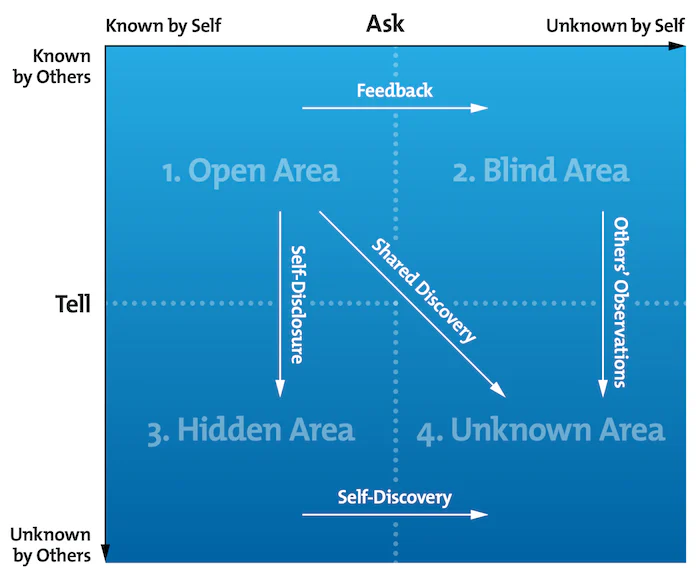Are you ready to take a gleaming gaze through the looking glass? The Johari Window is a powerful tool for self-awareness and interpersonal communication. It was developed by psychologists Joseph Luft and Harrington Ingham in the 1950s and has since become a staple in the fields of therapy, counseling, and professional development.

In this article, we’ll explore the Johari Window in depth, shining a light on each of its four quadrants: the open area, the blind area, the hidden area, and the unknown area. We’ll also look at real-life case studies and practical applications of the Johari Window, as well as critiques and limitations of the model. Whether you’re a therapist, a manager, or simply someone looking to improve your self-awareness, the Johari Window has something to offer.
Key Takeaways
- The Johari Window is a powerful tool for self-awareness and interpersonal communication.
- The model consists of four quadrants: the open area, the blind area, the hidden area, and the unknown area.
- Real-life case studies and practical applications of the Johari Window demonstrate its usefulness in therapy, counseling, and professional development.
Related Posts:
Unveiling the Johari Window
The Johari Window is a powerful tool that helps individuals and teams develop self-awareness and build trust. It is a framework that enables us to understand our conscious and unconscious biases and compare our own strengths and weaknesses to others’ perceptions of them. In this section, we will explore the origins, purpose, and four quadrants of the Johari Window, as well as its role in enhancing self-awareness.
Origins and Purpose
The Johari Window was developed by psychologists Joseph Luft and Harrington Ingham in 1955. The name “Johari” comes from a combination of their first names, Joe and Harry. The purpose of the Johari Window is to increase self-awareness and mutual understanding among individuals and groups. It is a tool that helps us understand how we see ourselves and how others see us.
The Four Quadrants of Johari Briefly Explained

The Johari Window is a grid divided into four quadrants. The quadrants represent different aspects of our personality, and they are labeled as follows:
-
Open or Arena: This quadrant represents aspects of ourselves that are known to us and to others. These are our strengths, weaknesses, behaviors, attitudes, and feelings that we are comfortable sharing with others – This is where we want to be.
-
Blind or Façade: This quadrant represents aspects of ourselves that are unknown to us but are known to others. These are our blind spots, our behaviors, attitudes, and feelings that we are not aware of but are visible to others.
-
Hidden or Avoidance: This quadrant represents aspects of ourselves that are known to us but are hidden from others. These are our secrets, fears, and vulnerabilities that we do not want others to know.
-
Unknown or Unknown: This quadrant represents aspects of ourselves that are unknown to us and to others. These are our undiscovered strengths, weaknesses, and potential that we have not yet explored.
Role in Enhancing Self-awareness
The Johari Window plays a crucial role in enhancing self-awareness. It helps us understand our own behavior, attitudes, and feelings, as well as how others perceive us. By increasing self-awareness, we can improve our communication skills, build stronger relationships, and become more effective leaders.
Related Posts:
- Ultimate Guide to Self-Awareness: Unveiling the Real You and Achieving Personal Enlightenment
- Discover the Best Version of Yourself: An Ultimate Guide to Personal Development
The Gleaming Gaze of Self-Awareness

Self-awareness is the foundation of personal growth and development. Understanding ourselves and our impact on others can lead to better communication, stronger relationships, and improved leadership skills. The Johari Window is a powerful tool that can help us develop self-awareness and enhance our interpersonal relationships.
Discussing Self-Awareness
Self-awareness is the ability to recognize and understand our emotions, thoughts, and behavior. It allows us to identify our strengths and weaknesses, and to recognize how our actions affect those around us. Developing self-awareness requires introspection and reflection, as well as feedback from others.
Johari Window and Self-Awareness
The Johari Window is a model that helps us understand ourselves and our relationships with others. It consists of four quadrants: Open, Blind, Hidden, and Unknown. Again, the Open quadrant represents what we know about ourselves and what others know about us. The Blind quadrant represents what others know about us, but we are unaware of. The Hidden quadrant represents what we know about ourselves, but we keep hidden from others. The Unknown quadrant represents what we don’t know about ourselves and what others don’t know about us.
Using the Johari Window can help us expand our Open quadrant by increasing our self-awareness and enhancing our communication skills. By sharing information about ourselves and seeking feedback from others, we can reduce our Blind quadrant and increase our Open quadrant. This can lead to improved relationships and increased trust.
Enhancing Communication
Effective communication is essential for building strong relationships and achieving success in both personal and professional settings. The Johari Window can help us enhance our communication skills by increasing our self-awareness and improving our ability to give and receive feedback.
By sharing information about ourselves and seeking feedback from others, we can reduce our Blind quadrant and increase our Open quadrant. This can lead to improved communication, as we become more aware of how our behavior affects others and are better able to express ourselves.
Building Trust
Trust is essential for building strong relationships and achieving success in both personal and professional settings. The Johari Window can help us build trust by increasing our self-awareness and improving our ability to give and receive feedback.
By sharing information about ourselves and seeking feedback from others, we can reduce our Blind quadrant and increase our Open quadrant. This can lead to increased trust, as we become more transparent and open with others as well as ourselves.
Related Posts:
- Ultimate Guide to Unlocking the Power of Gratitude: A Step-by-Step Path to Lasting Happiness
- How to Develop Positive Perception: A Step-by-Step Guide to Cultivating a Positive Mindset
- Mind Over Matter: Crush Negative Thoughts and Live Happier
- Mastering Habit Change: The Ultimate Guide to Replacing Bad Habits with Good Ones
- Elevate Your Self-Esteem: Master the Secrets of Inner Confidence
Shining a Light on the Open Quadrant

The Johari Window is a powerful tool for building self-awareness and trust in teams. The Open Quadrant, also known as the Arena, is the space where information is known to both the individual and others. This quadrant is where we can find valuable insights about ourselves and our relationships with others.
Exploration of the Open Quadrant
The Open Quadrant is where we can find our strengths, weaknesses, and blind spots. By sharing information about ourselves, we can increase our self-awareness and gain a better understanding of how others perceive us. This can help us build stronger relationships and improve our communication skills.
One way to explore the Open Quadrant is through feedback. Asking for feedback from others can be a valuable tool for gaining insights into our behaviors and attitudes. It can also help us identify areas for improvement and growth.
Contribution to Personal Growth
Exploring the Open Quadrant can contribute to personal growth by increasing our self-awareness and helping us identify areas for improvement. By understanding our strengths and weaknesses, we can make better decisions and take actions that align with our values and goals.
The Open Quadrant can also help us build stronger relationships with others. By sharing information about ourselves, we can build trust and create a more supportive and collaborative environment.
Related Posts:
- The Power of Empathy: Unlocking the Hidden Language of Human Connection
- Listen Up! How Active Listening Can Revolutionize Your Relationships
The Blind Spot – What Others See
As we explore the Johari Window, we come across the Blind Spot quadrant. This quadrant represents information that others can see about us, but we are not aware of. It is the quadrant where we have the least amount of self-awareness.
Discussion on the Blind Quadrant
The Blind Spot quadrant is often the most challenging to accept and understand. It can be difficult to acknowledge that there are things about ourselves that we do not know, but others do. It can be even more challenging to accept feedback from others about our Blind Spot quadrant. However, it is essential to recognize that this quadrant is where we have the most potential for growth and development.
The Blind Spot quadrant is often where our biases, assumptions, and blind spots reside. These are things that we may not even be aware of, but they can impact our interactions with others. By becoming aware of our Blind Spot quadrant, we can work to minimize the impact of these biases and assumptions and become more effective communicators and leaders.
Influence on Self-awareness
Becoming aware of our Blind Spot quadrant can have a significant impact on our self-awareness. By understanding what others see in us, we can gain a better understanding of how we are perceived by others. This can help us to identify areas where we may need to improve and areas where we excel.
Furthermore, by acknowledging our Blind Spot quadrant, we can become more open to feedback from others. This can help us to build stronger relationships with those around us and improve our communication skills. By being open to feedback, we can continue to learn and grow, both personally and professionally.
In conclusion, the Blind Spot quadrant is an essential aspect of the Johari Window. While it may be challenging to accept and understand, it is where we have the most potential for growth and development. By becoming aware of our Blind Spot quadrant, we can improve our self-awareness, become more effective communicators and leaders, and continue to learn and grow.
Hidden Aspects – Revealing Your True Self
At the heart of the Johari Window lies the Hidden Quadrant, where lies the unknown and undiscovered aspects of ourselves. This quadrant represents the things we know about ourselves but choose not to share with others, such as our deepest fears, insecurities, and desires. It also encompasses our blind spots, the things we are unaware of, but others can see in us.
Insights into the Hidden Quadrant
Exploring the Hidden Quadrant can be a challenging yet rewarding process. It requires us to delve deep into ourselves, confront our fears, and be vulnerable. By doing so, we can uncover hidden aspects of ourselves, gain new insights, and develop a deeper understanding of ourselves.
One way to explore the Hidden Quadrant is through self-reflection and introspection. This can involve journaling, meditation, or simply taking time to be alone with our thoughts. By reflecting on our experiences, emotions, and behaviors, we can gain a better understanding of our motivations, values, and beliefs.
Another way to uncover hidden aspects of ourselves is through feedback from others. This can involve asking trusted friends or colleagues for their honest opinions and observations about us. By listening to their feedback, we can gain new perspectives, identify blind spots, and develop a more well-rounded view of ourselves.
Role in Self-awareness
The Hidden Quadrant plays a crucial role in self-awareness, which is the foundation of personal growth and development. By becoming more aware of our hidden aspects, we can identify areas for improvement, work on our weaknesses, and build on our strengths. This can lead to greater self-confidence, resilience, and overall well-being.
However, it’s important to remember that exploring the Hidden Quadrant is a lifelong journey, and there will always be new aspects of ourselves to discover. It requires ongoing self-reflection, feedback, and a willingness to be vulnerable and open to change.
Related Posts:
Beyond the Known – The Ultimate Self-Discovery

In the depths of the Johari Window lies the concept of self-awareness, and the journey towards it is one of the most rewarding and challenging experiences one can undertake. The Johari Window is a powerful tool that can help us discover our blind spots, hidden potential, and the unknown aspects of our personality. In this section, we will explore the deeper dimensions of self-discovery beyond the known, and how the Johari Window can be used to unlock our true potential.
Deep Dive into the Unknown Quadrant
The Unknown quadrant of the Johari Window represents the aspects of our personality that are unknown to us and others. It is the realm of our untapped potential, hidden talents, and unexplored possibilities. The Unknown quadrant is a vast and mysterious realm that holds the key to our personal growth and transformation. To explore the Unknown quadrant, we must be willing to take risks, step out of our comfort zone, and embrace the unknown.
One way to explore the Unknown quadrant is to engage in activities that challenge us and push us beyond our limits. This could be anything from learning a new skill, taking up a new hobby, or traveling to a new place. By exposing ourselves to new experiences, we can expand our horizons and discover new aspects of ourselves that we never knew existed.
Concept of Personal Growth
Personal growth is a lifelong process of self-discovery and self-improvement. It is the journey towards becoming the best version of ourselves. The Johari Window is a powerful tool that can help us on this journey by providing us with insights into our strengths, weaknesses, and blind spots. By becoming more self-aware, we can identify areas for improvement and take steps to overcome our limitations.
One of the key concepts of personal growth is the growth mindset. A growth mindset is the belief that our abilities and intelligence can be developed through hard work, dedication, and perseverance. By adopting a growth mindset, we can overcome our limiting beliefs and achieve our full potential.
In conclusion, the Johari Window is a powerful tool that can help us on our journey towards self-discovery and personal growth. By exploring the Unknown quadrant and adopting a growth mindset, we can unlock our true potential and become the best version of ourselves.
Related Posts:
- Unlocking Potential: The Battle Between Growth and Fixed Mindset in Achieving Enlightenment
- Overcoming Limiting Beliefs: The Ultimate Guide to Smashing Mental Barriers
Johari Window in Therapy and Counseling
The Johari Window is a tool that can be used in therapy and counseling to help individuals gain a better understanding of themselves and their relationships with others. It was created by psychologists Joseph Luft and Harry Ingham in the 1950s, and has since been widely used in the field of psychology.
Mental Health
The Johari Window can be particularly helpful in promoting mental health. By increasing self-awareness and understanding of one’s thoughts and feelings, individuals can better manage their emotions and cope with stress. In therapy, the Johari Window can be used to help individuals identify their strengths and weaknesses, as well as their areas of growth. By exploring the “hidden” and “unknown” areas of the Johari Window, individuals can uncover underlying issues that may be contributing to their mental health struggles.
Relationship Counseling
The Johari Window can also be used in relationship counseling to improve communication and build trust between partners. By increasing self-awareness and understanding of one’s own thoughts and feelings, individuals can better express their needs and desires to their partner. Additionally, by exploring the “blind” and “unknown” areas of the Johari Window, individuals can gain a better understanding of their partner’s perspective and improve their ability to empathize with one another.
In conclusion, the Johari Window is a powerful tool that can be used in therapy and counseling to promote self-awareness, improve communication, and build stronger relationships. By exploring the different areas of the Johari Window, individuals can gain a better understanding of themselves and their relationships with others.
Johari Window in Professional Settings
In professional settings, the Johari Window can be an effective tool for team building, leadership development, and conflict resolution.
Team Building
The Johari Window can help team members better understand themselves and each other. By increasing self-awareness and mutual understanding, team members can build trust and improve communication. The Johari Window can also help identify strengths and weaknesses within the team, allowing for better delegation of tasks and more effective collaboration.
Leadership Development
Leaders who use the Johari Window can gain a deeper understanding of their own strengths and weaknesses, as well as those of their team members. This knowledge can help leaders build stronger relationships with their team members and improve communication. By using the Johari Window to identify areas for personal growth, leaders can become more effective in their roles.
Conflict Resolution
The Johari Window can be used to resolve conflicts by helping individuals better understand themselves and each other. By identifying areas of overlap and differences, individuals can work towards finding common ground and resolving conflicts. The Johari Window can also help individuals identify their own blind spots and biases, which can be a source of conflict.
Overall, the Johari Window can be a powerful tool for improving self-awareness, communication, and relationships in professional settings. By using this tool, individuals and teams can work towards achieving their goals more effectively and building stronger, more productive relationships.
Practical Applications

The Johari Window is a powerful tool that can be applied in various contexts to improve self-awareness, communication, and personal development. In this section, we will explore some practical applications of the Johari Window.
Application in Personal Development
The Johari Window can be used as a personal development tool to increase self-awareness and identify areas for improvement. By understanding our blind spots and unknown areas, we can work towards expanding our open area and reducing our hidden area.
One way to apply the Johari Window in personal development is to seek feedback from others. By asking for honest feedback, we can gain insights into how others perceive us and identify areas for improvement. This feedback can be used to expand our open area and reduce our blind and hidden areas.
Another way to apply the Johari Window is to use it as a framework for setting personal goals. By identifying our strengths and weaknesses, we can set goals that are aligned with our values and aspirations. For example, if we identify communication as an area for improvement, we can set a goal to attend a public speaking course or practice active listening.
Enhancing Communication
The Johari Window can also be used to enhance communication in personal and professional relationships. By understanding our own communication style and the communication styles of others, we can improve our ability to connect and build trust.
One way to apply the Johari Window in communication is to use it as a framework for giving and receiving feedback. By using the Johari Window as a guide, we can provide feedback that is specific, constructive, and focused on expanding the open area. Similarly, we can receive feedback in a way that is open-minded and non-defensive, allowing us to expand our self-awareness and improve our communication skills.
Another way to apply the Johari Window in communication is to use it as a tool for conflict resolution. By understanding our own perspective and the perspective of others, we can find common ground and work towards a mutually beneficial solution. This can be achieved by using the Johari Window as a framework for exploring different perspectives and identifying areas of overlap and difference.
Related Posts:
- From Dreamer to Achiever: The Ultimate Guide to Personal Goals
- Mastering Self-Discipline: Be Your Own Hero and Unlock Your Potential
- Network Like You Mean It: Strategies for Personal and Professional Growth
- The Ultimate Guide to Mastering Communication Skills for Deeper Connections!
Case Studies of Johari Window Application
At its core, the Johari Window is a tool for self-awareness and communication. It helps individuals and teams understand their strengths, weaknesses, and blind spots, and gives them a framework for sharing that information with others. Here are a few case studies that demonstrate the power of the Johari Window in action.
Case Study 1: Team Building
A team of software developers was struggling to work together effectively. They were all highly skilled, but they had trouble communicating and collaborating. The team leader decided to use the Johari Window to help them improve their teamwork.
Each team member created their own Johari Window, with input from their colleagues. They identified their strengths, weaknesses, and blind spots, and shared that information with the rest of the team. As a result, they were able to better understand each other’s communication styles, work preferences, and areas of expertise.
With this newfound self-awareness, the team was able to work more effectively together. They were better able to delegate tasks, communicate their needs, and support each other when necessary. The team leader reported that the Johari Window exercise was a turning point for the team, and that they were now much more productive and collaborative.
Case Study 2: Leadership Development
A manager at a large corporation was struggling with leadership development. She had a hard time giving feedback to her team members, and often felt like she wasn’t getting the results she wanted. She decided to use the Johari Window to help her become a better leader.
With the help of a coach, the manager created her own Johari Window. She identified her strengths, weaknesses, and blind spots, and shared that information with her coach. Together, they worked on strategies for improving her communication and leadership skills.
Over time, the manager became more self-aware and confident in her leadership abilities. She was better able to give feedback to her team members, and was more effective at delegating tasks and managing projects. She reported that the Johari Window exercise was a valuable tool for her personal and professional development.
Case Study 3: Conflict Resolution
Two employees at a small business were having a hard time working together. They had different communication styles and work preferences, and often clashed over how to approach projects. The business owner decided to use the Johari Window to help them resolve their conflicts.
Each employee created their own Johari Window, with input from the other employee. They identified their strengths, weaknesses, and blind spots, and shared that information with each other. As a result, they were better able to understand each other’s perspectives and work together more effectively.
The business owner reported that the Johari Window exercise helped the employees resolve their conflicts and improve their working relationship. They were able to communicate more effectively, delegate tasks more efficiently, and work together to achieve their goals. The business owner was pleased with the outcome, and said that the Johari Window was a valuable tool for conflict resolution.
Overall, these case studies demonstrate the power of the Johari Window in a variety of contexts. Whether you’re trying to improve teamwork, develop your leadership skills, or resolve conflicts, the Johari Window can help you become more self-aware and communicate more effectively.
Real-Life Stories

Presenting Real-Life Stories
The Johari Window is a powerful tool for self-discovery and personal growth. It has been used by millions of people around the world to gain a better understanding of themselves and their relationships with others. Here are a few real-life stories that demonstrate the impact of the Johari Window.
Story 1: John was a successful businessman who had been married for 20 years. He had always considered himself to be a confident and self-assured person, but he had a tendency to be controlling and domineering in his relationships. One day, his wife suggested that they try the Johari Window exercise together. As they went through the process, John was surprised to discover that there were many things about himself that he had never realized before. He learned that he had a deep-seated fear of vulnerability and that he often used his power and control to mask his insecurities. With this newfound awareness, John was able to work on his issues and become a more loving and compassionate partner.
Story 2: Sarah was a college student who was struggling with her self-esteem. She had always felt like she didn’t fit in with her peers and had a hard time making friends. After learning about the Johari Window in her psychology class, Sarah decided to try it out for herself. As she worked through the exercise, she realized that she had been hiding her true self from others for fear of rejection. With this realization, she was able to start being more authentic and vulnerable with her peers. To her surprise, she found that people responded positively to her newfound openness and she was able to make meaningful connections with others.
Impact of the Johari Window
The Johari Window can have a profound impact on our lives. By increasing our self-awareness, we are able to better understand our strengths and weaknesses, our fears and desires, and our relationships with others. This increased awareness can lead to greater empathy, compassion, and understanding, as well as improved communication and more fulfilling relationships.
The Johari Window can also be a powerful tool for personal growth and development. By identifying areas where we need to improve, we can work on developing new skills and behaviors that will help us achieve our goals and become the best version of ourselves.
Overall, the Johari Window is a valuable tool for anyone who is looking to gain a better understanding of themselves and their relationships with others. Whether you are a business leader, a student, or just someone who wants to live a more fulfilling life, the Johari Window can help you achieve your goals and reach your full potential.
Expanding the Johari Window
As we continue to explore the concept of the Johari Window, we can expand our understanding of ourselves and others by engaging in various exercises and techniques. By broadening our self-awareness, we can uncover areas of growth and develop a deeper understanding of our own strengths and weaknesses. In this section, we will explore some activities and practices that can help us expand our Johari Window.
Exercises and Techniques
One way to expand our Johari Window is by engaging in exercises and techniques that help us uncover hidden aspects of ourselves. A popular exercise is the “blind spot” activity, where we ask others for feedback on our behavior and personality. This can help us identify areas of ourselves that we may not be aware of and can lead to personal growth.
Another technique is journaling, which can help us reflect on our thoughts and feelings. By writing down our experiences, we can gain insight into our own behavior and patterns. This can help us identify areas of ourselves that we may need to work on or improve.
Broadening Self-Awareness
Broadening our self-awareness can help us expand our Johari Window. One way to do this is by practicing mindfulness. Mindfulness involves being present in the moment and observing our thoughts and feelings without judgment. This can help us become more aware of our own behavior and patterns.
Another way to broaden our self-awareness is by seeking feedback from others. By asking others for feedback on our behavior and personality, we can gain insight into how we are perceived by others. This can help us identify areas of ourselves that we may need to work on or improve.
Personal Growth Activities
Engaging in personal growth activities can help us expand our Johari Window. These activities can include things like reading self-help books, attending personal development workshops, or working with a life coach. By engaging in these activities, we can gain insight into ourselves and develop a deeper understanding of our own strengths and weaknesses.
In conclusion, expanding our Johari Window involves engaging in exercises and techniques, broadening our self-awareness, and engaging in personal growth activities. By doing so, we can develop a deeper understanding of ourselves and others, and uncover areas of growth and personal development.
Critiques and Limitations of the Johari Window

The Johari Window is a popular framework used to increase self-awareness and build trust in teams. However, like any model, it has its limitations. In this section, we will explore some of the critiques and limitations of the Johari Window.
Validity and Reliability
One critique of the Johari Window is its validity and reliability. While the model is widely used, some critics argue that it lacks empirical evidence to support its effectiveness. The model is based on self-disclosure and feedback, which can be subjective and biased. The quality and quantity of personal information shared is ultimately left to the judgment of the individuals in the group. Therefore, it is important to use the Johari Window with caution and not rely solely on it for building self-awareness and trust.
Cultural Considerations
Another limitation of the Johari Window is its cultural considerations. The model was developed in Western cultures and may not be applicable to other cultures. For example, in some cultures, self-disclosure is not encouraged, and feedback is given indirectly. Therefore, it is important to consider cultural differences when using the Johari Window.
To overcome these limitations, it is important to use the Johari Window in conjunction with other tools and techniques. For example, using objective assessments, such as personality tests, can provide a more accurate picture of an individual’s strengths and weaknesses. Additionally, it is important to consider cultural differences and adapt the model accordingly.
In conclusion, while the Johari Window is a useful tool for building self-awareness and trust, it is important to be aware of its limitations. By using the model in conjunction with other tools and techniques and adapting it to cultural differences, we can maximize its effectiveness and achieve better results.
Johari Window and other Psychological Models
As a tool for self-awareness, the Johari Window is unique in that it emphasizes the importance of feedback from others in order to gain a more complete understanding of oneself. However, there are other psychological models that can also be useful in understanding oneself and others. In this section, we will briefly compare the Johari Window with two other popular models: Myers-Briggs and DISC.
Comparison with Myers-Briggs
The Myers-Briggs Type Indicator (MBTI) is a personality assessment tool that categorizes individuals into one of 16 personality types based on four dichotomies: extraversion vs. introversion, sensing vs. intuition, thinking vs. feeling, and judging vs. perceiving. While the Johari Window focuses on self-awareness and feedback from others, the MBTI is more focused on identifying personality traits and preferences.
One key difference between the two models is that the Johari Window emphasizes the importance of feedback from others, while the MBTI is more focused on self-reporting. Additionally, while the Johari Window is a relatively simple model that can be applied to a wide range of situations, the MBTI is a more complex model that requires a trained professional to administer and interpret.
Comparison with DISC
The DISC model is another popular personality assessment tool that categorizes individuals into one of four personality types based on their dominant traits: dominance, influence, steadiness, and conscientiousness. Like the Johari Window, the DISC model emphasizes the importance of understanding oneself and others in order to improve communication and build better relationships.
One key difference between the two models is that the Johari Window focuses on self-awareness and feedback from others, while the DISC model is more focused on identifying personality types and how they interact with others. Additionally, while the Johari Window is a relatively simple model that can be applied to a wide range of situations, the DISC model is more focused on workplace dynamics and may not be as useful in other contexts.
Overall, while the Johari Window is a unique and valuable tool for self-awareness and building better relationships, it is important to keep in mind that there are other psychological models that can also be useful in understanding oneself and others. By combining the insights from different models, we can gain a more complete understanding of ourselves and those around us.
Conclusion

In conclusion, the Johari Window is a powerful tool that can help individuals better understand their relationship with themselves and others. By dividing our self-awareness into four quadrants, we can identify our strengths, weaknesses, blind spots, and unknown areas. This can help us to build better relationships, communicate more effectively, and achieve our goals.
Through the Johari Window, we can learn to be more honest with ourselves and others, and to embrace our vulnerabilities. By sharing our hidden areas with others and receiving feedback, we can gain new insights and perspectives that can help us to grow and develop.
It’s important to remember that the Johari Window is not a one-time exercise, but an ongoing process of self-discovery and self-improvement. By regularly revisiting our self-awareness and seeking feedback from others, we can continue to expand our open area and reduce our blind and hidden areas.
Overall, the Johari Window is a valuable tool for anyone who wants to improve their self-awareness, communication, and relationships. By embracing this tool and committing to ongoing self-improvement, we can unlock new levels of personal and professional success.
Resources and References
To learn more about the Johari Window and how it can be used to improve self-awareness and interpersonal relationships, there are several resources available.
One great source is the book “Finding Sanctuary – Monastic Steps for Everyday Life” by Abbot C. Jamison, which explores the concept of the Johari Window in depth and offers practical advice for applying it in daily life.
Another helpful resource is the article “How to Use the Johari Window to Improve Leadership” by PositivePsychology.com, which provides a clear and concise overview of the model and its applications in the workplace.
For a more academic perspective, the article “Johari Window” on Wikipedia provides a detailed history of the model’s development and its various applications in psychology and business.
It’s important to note that while the Johari Window can be a useful tool for personal and professional growth, it should not be used as a substitute for therapy or counseling. If you are struggling with mental health issues or interpersonal conflicts, it’s important to seek professional help from a licensed therapist or counselor.
Overall, the Johari Window is a powerful tool for improving self-awareness and building stronger relationships with others. By exploring the model and its various applications, we can gain a deeper understanding of ourselves and our interactions with the world around us.
Frequently Asked Questions

What are the benefits of using the Johari Window model?
Using the Johari Window model can help individuals and teams develop a better understanding of their own strengths and weaknesses, as well as the perceptions of others. This increased self-awareness can lead to improved communication, trust, and collaboration. By identifying areas of improvement, individuals and teams can work towards personal and professional growth.
How can the Johari Window model improve communication?
The Johari Window model can improve communication by encouraging individuals to share information about themselves and to listen to others. By increasing self-awareness and understanding the perceptions of others, individuals can communicate more effectively and build stronger relationships. The model also helps to identify areas of miscommunication and can provide a framework for resolving conflicts.
What are some practical applications of the Johari Window model?
The Johari Window model can be applied in a variety of settings, including personal relationships, team building, leadership development, and therapy. It can be used to facilitate discussions about personal and professional growth, to improve communication and collaboration within teams, and to increase self-awareness and empathy.
How does the Johari Window model relate to self-awareness?
The Johari Window model is a tool for increasing self-awareness by identifying the areas of ourselves that are known to us and to others, as well as the areas that are unknown to us and to others. By increasing our self-awareness, we can better understand our own strengths and weaknesses and work towards personal and professional growth.
What are the limitations of the Johari Window model?
The Johari Window model is limited by the fact that it relies on self-disclosure and the willingness of individuals to share information about themselves. It may also be limited by cultural and social factors that influence the way individuals perceive themselves and others. Additionally, the model does not account for the impact of external factors, such as societal norms and systemic oppression, on an individual’s self-awareness.
How can the Johari Window model be adapted for different contexts?
The Johari Window model can be adapted for different contexts by modifying the language and concepts used to fit the specific needs of the individuals or groups involved. For example, in a therapy setting, the model may be used to explore the unconscious mind, while in a business setting, it may be used to improve team dynamics and communication. The model can also be adapted for use in cross-cultural contexts by taking into account the different cultural norms and values of the individuals involved.












